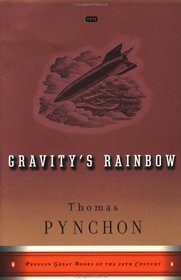Search -
Gravity's Rainbow
Gravity's Rainbow
Author:
Tyrone Slothrop, a GI in London in 1944, has a big problem. Whenever he gets an erection, a Blitz bomb hits. Slothrop gets excited, and then (as Thomas Pynchon puts it in his sinister, insinuatingly sibilant opening sentence), "a screaming comes across the sky," heralding an angel of death, a V-2 rocket. The novel's title, Gravity's Rainbow, ref... more »
Author:
Tyrone Slothrop, a GI in London in 1944, has a big problem. Whenever he gets an erection, a Blitz bomb hits. Slothrop gets excited, and then (as Thomas Pynchon puts it in his sinister, insinuatingly sibilant opening sentence), "a screaming comes across the sky," heralding an angel of death, a V-2 rocket. The novel's title, Gravity's Rainbow, ref... more »
ISBN-13: 9780140283389
ISBN-10: 0140283382
Pages: 776
Rating: 3
ISBN-10: 0140283382
Pages: 776
Rating: 3
3.2 stars, based on 3 ratings
Publisher: Penguin Books
Book Type: Paperback
Other Versions: Hardcover
Members Wishing: 11
Reviews: Amazon | Write a Review
Book Type: Paperback
Other Versions: Hardcover
Members Wishing: 11
Reviews: Amazon | Write a Review
Genres:




